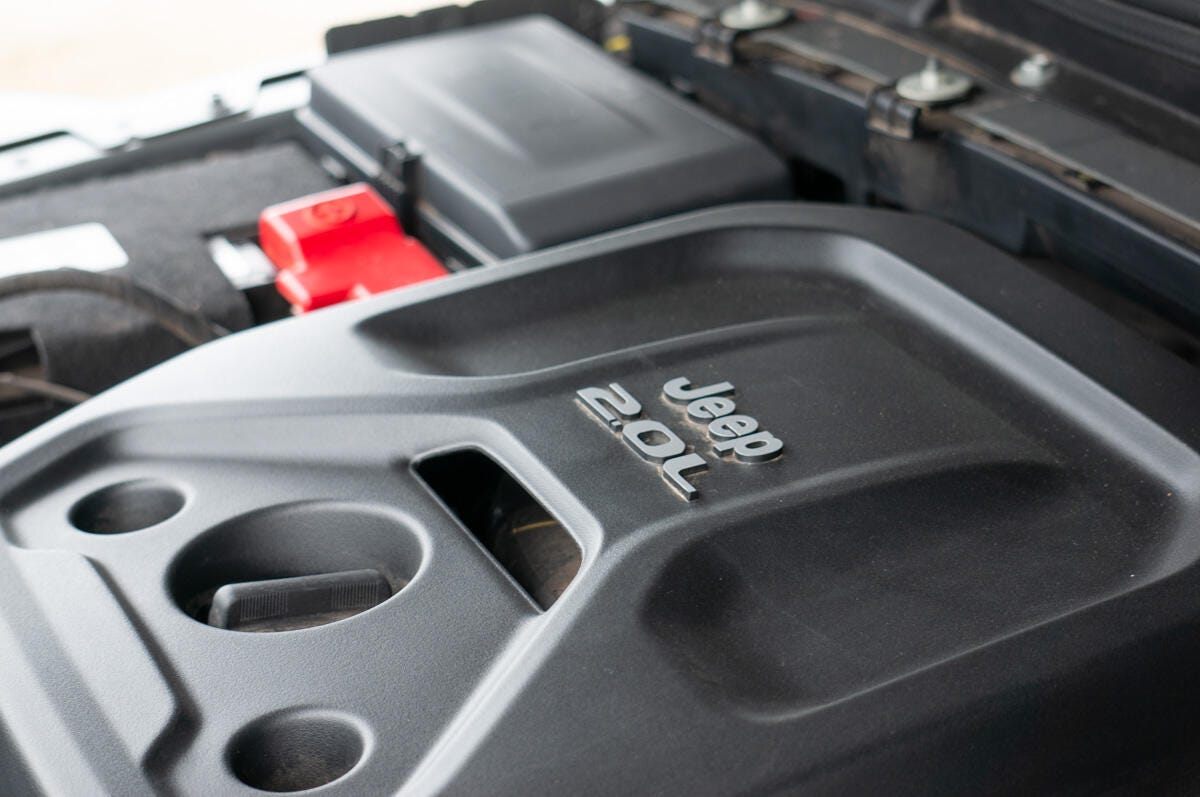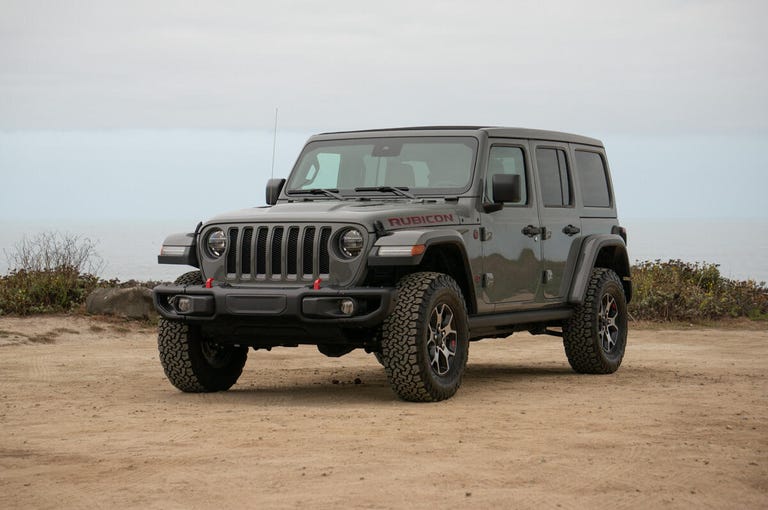 Why You Can Trust CNET
Why You Can Trust CNET 2019 Jeep Wranger Unlimited Rubicon eTorque review: More torque, more efficiency, almost no compromises
From its iconic design to its legendary ruggedness and now its high-tech eTorque powertrain, there is a lot to love about the 2019 Jeep Wrangler.
We've taken a look at pretty much every variant of the new JL-series Jeep Wrangler. We've dug into the chassis' capabilities and tested the off-road prowess and cabin/safety tech. We've even tackled the Rubicon Trail in a Wrangler Rubicon. Now, it's time to take a look at the most interesting new development -- well, besides the addition of a diesel, anyway. This Wrangler has Jeep's new 48-volt, mild-hybrid eTorque engine. Yes, an electrified Jeep.
The Good
The Bad
The Bottom Line
Does electrification hurt or help the legendary Wrangler? It all depends on what you're looking for in a Jeep.
Extra motor
The eTorque hardware is similar to the setup that's under the hood of the Ram 1500 eTorque, but mated to a smaller four-cylinder engine instead of a V6. We're talking a belt-driven, water-cooled, AC-induction motor that adds 130 pound-feet of torque assist under acceleration.
The electric motor also replaces the Wrangler's 12-volt alternator, acting as a generator during light cruising and charging the eTorque system's 0.43-kilowatt-hour battery. The lithium-ion pack is fan-cooled, pulling air from the cabin and exhausting outside. Sound insulation keeps most of the fan noise from the cabin, but I could kind of hear the hum if I really listened.
The eTorque system uses a traditional 12-volt lead-acid battery for the accessory and infotainment systems, but it is charged from the 48-volt system via a DC-to-DC converter, since there's no traditional alternator. Interestingly, there is a still a traditional, 12-volt starter, which the Wrangler uses for cold starts. However, the eTorque motor handles all subsequent anti-idling starts and stops once the gasoline engine is warmed up.
Extra torque
The combustion engine in question is a 2.0-liter, turbocharged I4 mated to the Wrangler's familiar four-wheel-drive system and an eight-speed automatic transmission. Along with the electric components, the Wrangler eTorque makes a combined 270 horsepower, which is just a bit less than the 3.6-liter V6's 285 ponies. However, with its peak 295 combined pound-feet of torque, it bests the V6 by 35 lb-ft.
The turbo engine and electric motor work well together, for responsive and smooth around-town performance. The eTorque system boosts nicely during off-the-line acceleration and the turbo engine delivers solid torque from the engine's midrange and beyond. The transition is smooth -- you almost can't tell there's electro-trickery happening behind the scenes -- and the shifts are even smoother with the e-motor filling in the torque gaps between gear changes.

The eTorque system adds a 48-volt electric motor to a 2.0-liter turbocharged engine for a total of 295 pound-feet of torque.
For my money, I think I'd take the eTorque's smooth around-town performance and torque advantage -- which should come in handy for a low-speed crawler such as the Wrangler -- over the technically more powerful V6. However, I can see how traditional Wrangler owners looking for the most rugged powertrain possible could be put off by the additional complexity of the mild-hybrid system. Long-term reliability, of course, is still an unknown.
It also remains to be seen how the 2.0-liter turbo eTorque responds to modifications, something that I know Jeep guys and gals love to do. For enthusiasts, rock crawlers and overlanders, perhaps the 442-pound-foot, 3.0-liter EcoDiesel V6 would be the better, more robust option.
Extra efficiency
For now, the primary benefit of going eTorque is the balance of excellent out-of-the-box torque delivery without any real hit to fuel efficiency. In fact, the electrified Wrangler gets a bit of an economy boost.
Regenerative braking captures energy while stopping, and combined with a smooth stop-start system and strong low-speed electric assist, the Wrangler is much more frugal around town. My four-door Wrangler eTorque Unlimited claims up to 22 combined miles per gallon, which breaks out to 22 city and 24 highway mpg. I'll save you a Google search -- that's 4 more miles per gallon in the city and 1 more on the highway than a comparably equipped Wrangler V6.
eTorque models keep all of the Wrangler's off-road hardware intact, from the 4x4 system with lockable differentials to the Trail Rated suspension and chassis.
Extra grand
The Wrangler's eTorque system is only about $1,000 more than the Pentastar V6, so there's not even much of a hybrid tax associated with electrifying this Jeep.
The cheapest eTorque model is the base Wrangler Sport 4x4 2-Door, which starts at $28,045 before you add $1,000 for the eTorque motor. You also have to add $2,000 for the automatic transmission and $1,295 for air conditioning -- you can't get the eTorque without checking those boxes -- as well as a $1,495 destination charge. That's $33,835 out the door.
Now, my 2019 Jeep Wrangler Unlimited Rubicon 4x4 eTorque starts at a significantly higher $46,040 thanks to its longer list of standard equipment and other optional amenities. With close to a full suite of driver-assistance tech, leather seats, the 8.4-inch Uconnect navigation suite and more, this example rolled into the garage with a $58,890 as-tested sticker.
With only a minimal hybrid premium, more torque and efficiency, there are almost no trade-off for choosing the eTorque upgrade. At least, not for more casual owners...
For more casual Jeep buyers interested in the Wrangler for its rugged style, all-weather capabilities and on-road manners, there's almost no reason not to check that eTorque box. It's smoother, it's more efficient and, using FuelEconomy.gov's estimated annual fuel cost calculator, the eTorque system should pay for itself within five years for drivers who average around 15,000 miles per year. Of course, your mileage will vary.
More hardcore off-road enthusiasts or owners who'll want to modify their rides will probably want check out the aforementioned EcoDiesel with more torque, proven reliability and a more traditional upgrade and modification path. On the other hand, if the mild-hybrid isn't hybrid-y enough for you, Jeep's got a Wrangler plug-in hybrid coming next year. We'll be keeping our eyes peeled for that one, and so should you.


